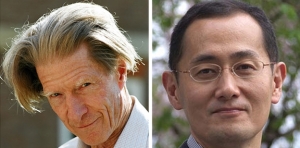Earlier in September, I stumbled across a reference to John Gurdon’s 1960s work on somatic nuclear cell transfer (SNCT) as I was doing background research for a project on embryology. To be precise, it was more like a face plant rather than a stumble. I fell head first and was hooked. This shit was incredible.
His research inspired some fascinating questions that I had wanted to explore in my own work, but they were eventually pushed to the wayside as I had more pressing matters to attend. Still, the impression had been made. This man was a pioneer; he caused us to rewrite the science textbook. Why had no one talked about him?
Fast forward to Monday morning, October the 8th. I’m at the airport, waiting to catch an early flight out of Houston. Bleary-eyed, I begin flipping through NPR’s science blog on my phone, trying to ameliorate the pain of being forced awake so early by indulging myself in the latest headlines. Scrolling down, an image of a man with wild hair and a mad scientist grin catches my eye. The 2012 Nobel Prize winners, just announced.

John Gurdon (UK) and Shinya Yamanaka (JP): 2012 Nobel Prize winners for the category of Physiology or Medicine
Wait, this was my guy! A brilliant yet highly under-appreciated researcher that seemed to fade into obscurity. And he had just won the 2012 Nobel Prize? This was a bizarre coincidence for me personally, but supremely vindicating and satisfying to know that 50 years later, this man’s work had been formally recognized by the international community. And although I’m partial to Gurdon, Yamanaka’s work has been extraordinarily groundbreaking, as well. Both researchers have made historic contributions to the fields of developmental biology and stem cell research. (I plan to review their work in another post, but for now, you can read about their incredible achievements here.)
High five, bros. Congrats for the most important discoveries for the benefit of mankind.
I became so intrigued by Gurdon’s (and later, Yamanaka’s) work because it demonstrates the fallibility of human knowledge—and the stagnation caused by unchallenged conventional wisdom—but so beautifully highlights the ways in which scientific progress and innovation revolutionize our understanding of the world. It is a travesty of infinite proportions that unsound political agendas—designed to appease the religious right and social extremists who wish to return to the moral universe of the 1800s—jeopardize the fundamental sanctity of this kind of scientific work.
This science strengthens our understanding of what it means to be human. But politicians want to put a moratorium on basic research because of silly, magical ideas—a kind of Dark Age thinking of the 21st century—that foster an inaccurate and perversely reductionist philosophy of our human origins. The magical moment when sperm hits the egg, and God’s plan is set in motion…Even without the religious overtones, this view of life is reductionist. But we can never move to the nuances, because the self-righteous, militant dogmatism of those who oppose science has a chilling effect on society, effectively silencing public discourse.
If a fertilized egg is a full-fledged person, how does one morph from a person to a trophoblastic tumor? This might sound iconoclastic, but it need not be inflammatory. I am not denying that something critical happens at the “moment(s)” of conception; I am merely suggesting that there is a mass deficit in the understanding of our basic developmental biology.
Life can be a continuous process, progressing in stages. But it is not a straight line trajectory, nor does it move clockwise in a circle. It can reverse its path or end up at a point that a teleological model simply cannot account for: identical twins, conjoined twins, parasitic twins, chimeras, tumors, cancers, spontaneous abortion, etc. A fertilized egg (or two) can turn into any of these things. And then, as Gurdon and Yamanaka showed: my skin cell can give rise to a new embryo, and my skin cell can also revert to an embryonic-like state. Astonishingly, life is multi-directional and can assume many unexpected paths in between. And genetic organisms, new forms of life, etc. can be created in an assortment of ways.
Science does not always fit neatly into prevailing human thought patterns, or comply with how we want to see the world. So we need to change the way we think, or at least be open to new possibilities.
The extremist, however, is completely unwilling to reflect critically upon his own beliefs. But scientific reality will never conform to the extremist’s worldview, and so he will forever deny its truth.
The dark, twisted paradox is that this dangerous mindset has infiltrated our political legislature. The men and women who are least qualified to direct our nation’s science policy are, in a cruel twist of fate, the ones calling the shots.
On one hand, we have brilliant thinkers like Gurdon and Yamanaka, who are using science to improve the plight of man. On the other end, we have a bunch of bozo politicians like Todd Akin (R-Mo) and Paul Broun (R-Ga), who possess not even the slightest bit of scientific literacy yet use their positions of power to legislate the fields that inevitably give rise to this type Nobel Prize-winning research. Oh, but we don’t want that research anyway:
“All that stuff I was taught about evolution, embryology, Big Bang theory, all that is lies straight from the pit of hell.”
…says Mr. Broun. Anti-science looney and member of the United States House Committee on Science.
Welcome to the circus, where Jesus rides dinosaurs, women’s bodies shut things down, and perpetuating magical beliefs does not, in any way, jeopardize the United States’ future as a leader in science and technology.
